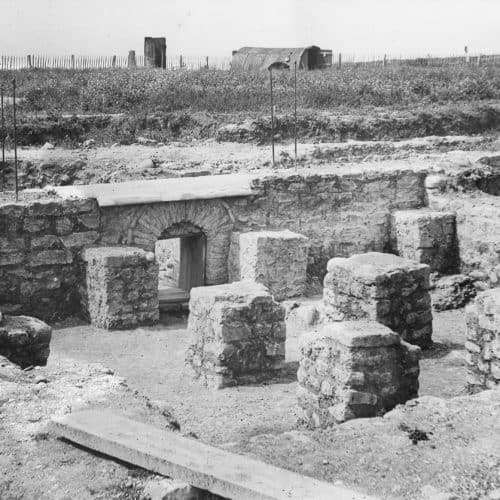Romans activity 5: a load of hot air
Overview
A hypocaust was the must-have convenience in Roman villa design. Research, design and create a model hypocaust using recycled materials.
Learning objectives
Increased knowledge and understanding of science (including the convection and conduction of heat) archaeology and Folkestone Roman Villa.
Research skills.
Design technology skills (design and build a working model hypocaust).
Curriculum links
KS1-2 History (Romans, Local History Study).
KS1-2 Science (materials, combustion, the convection and conduction of heat)
KS1-4 Design technology (design and build a working model hypocaust).
Introduce the Folkestone Roman Villa site. Then show the children the above photograph of Room 12, excavated in 1924 by Samuel Winbolt. It has lots of neatly stacked pillars. See Learn with Objects Romans 6: Hypocaust.
Ask the children the questions below:
- What can you see in this room?
- What are the pillars made from?
- What are the pillars for?
- Are they plinths for Roman statues?
- Or part of a giant game?
- What ideas have you got. Use your imagination.
- What do you think the arch is for?
- Is it a doorway? Look at the size of the people in the background.
- Is it for people, animals or something else to pass through?
- Do you think it’s at ground floor level?
- What if we are looking beneath the floor?
- Does this change your ideas?
- Samuel Winbolt called it a hypocaust. What is a hypocaust?
Send the children off to find out more about hypocausts using Learn with Objects Romans 6: Hypocaust and other websites.
- What is a hypocaust?
- Who had them?
- Why? There’s more than 1 reason.
- How did they work?
The website below is great for children and adults. It includes lots of photos of Bignor Roman Villa in East Sussex. Scroll down to find the photos of the Winter Dining Room, with it’s fabulous mosaics, and section of collapsed floor, revealing the hypocaust beneath.
https://www.romeartlover.it/Bignor.html
Background info about the Folkestone Roman Villa hypocaust
The black and white photo shows part of the hypocaust or underfloor heating system at Folkestone Roman Villa.
A charcoal furnace was lit by a slave in the stoke hole, a tiny room (Room 11) on the far side of the arch.
Hot air from the furnace passed through the arch and between the columns, heating the floor above (now missing). The floor was supported on top of the columns.
This room was almost certainly used by the wealthy family who owned the villa. It was next to Room 15 (a sitting room with mosaic remains).
It would have been a warm and cosy room in the cold winter months and was probably a favourite place for the family to gather. Did they use it as a winter dining room like the family at Bignor, or as a warm place to relax? What do the children think.
A second hypocaust system at Folkestone Roman Villa was used to heat the nearby bath house (rooms 1-10). This had a separate stokehole (room 1).
Watch this video clip to see the much grander Roman Baths at Aquae Sulis (modern day Bath) and the underfloor heating system used to warm them.
Make a hypocaust
This BBC Hands-on History download includes how to make a simple hypocaust for KS1-2 children.
http://downloads.bbc.co.uk/history/handsonhistory/romans_villas.pdf
Children can build their hypocaust using card, glue, paints and scissors.
Or the children could replicate one of the two hypocaust systems at Folkestone Roman Villa. Look at the Plan of Folkestone Roman Villa and the Key to the Plan of Folkestone Roman Villa below:
http://www.canterburytrust.co.uk/folkestone/gallery0114.htm
http://www.canterburytrust.co.uk/folkestone/gallery0115.htm
Using the plan of Folkestone Roman Villa as a reference, copy the layout of one of the two hypocaust systems – the simpler one that heated just Room 12, or the more complicated one that heated Rooms 1-8 in the bathhouse.
Make this a scale drawing, on a base sheet of white card, enlarging the measurements to make your model approximately A3 size (or slightly larger).
Next create the pilae stacks (small squares of corrugated card work well) and build the floors and rooms on top, (larger sheets of corrugated card which you can paint and decorate) with the family (made from modelling clay or similar) relaxing, dining or enjoying a soak in the baths.
To test your hypocaust why not use a hair drier (PAT tested and under adult supervision) to assess the flow of warm air beneath the floor?

